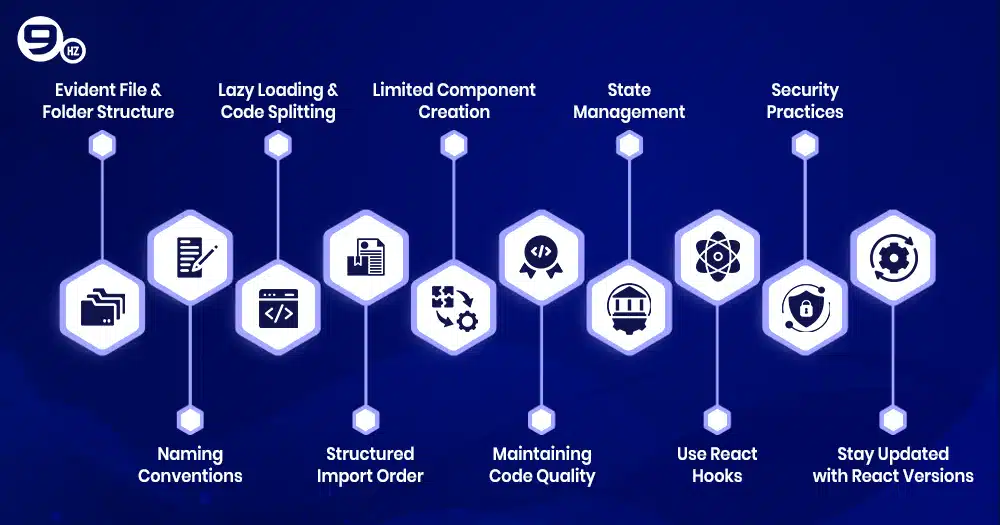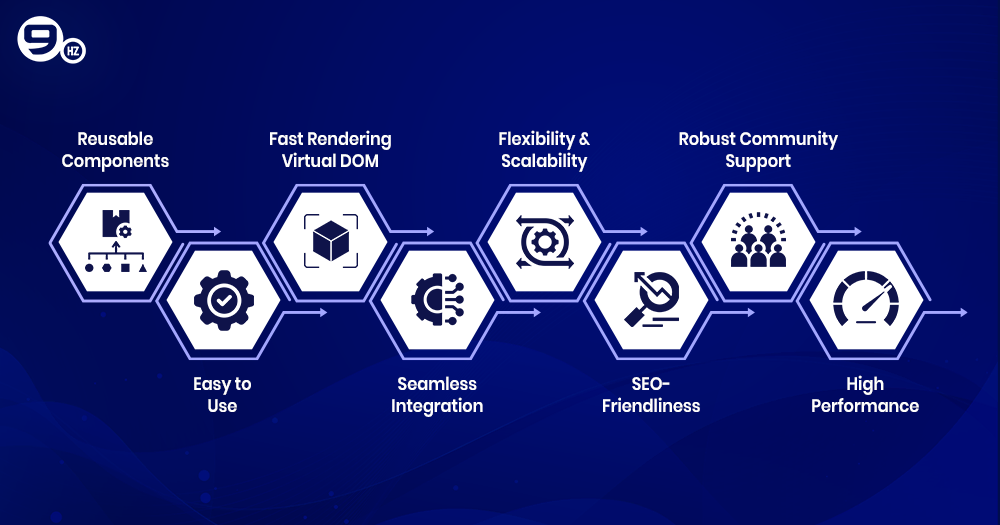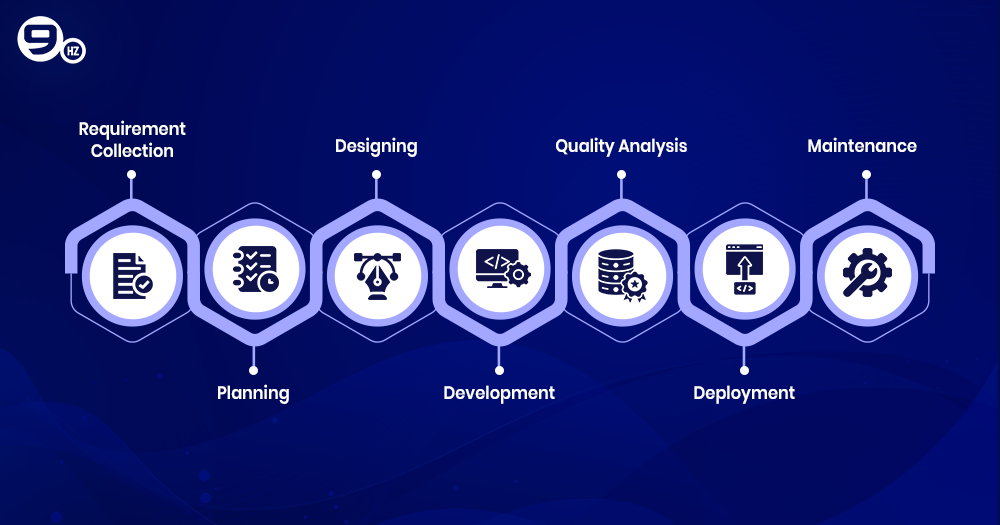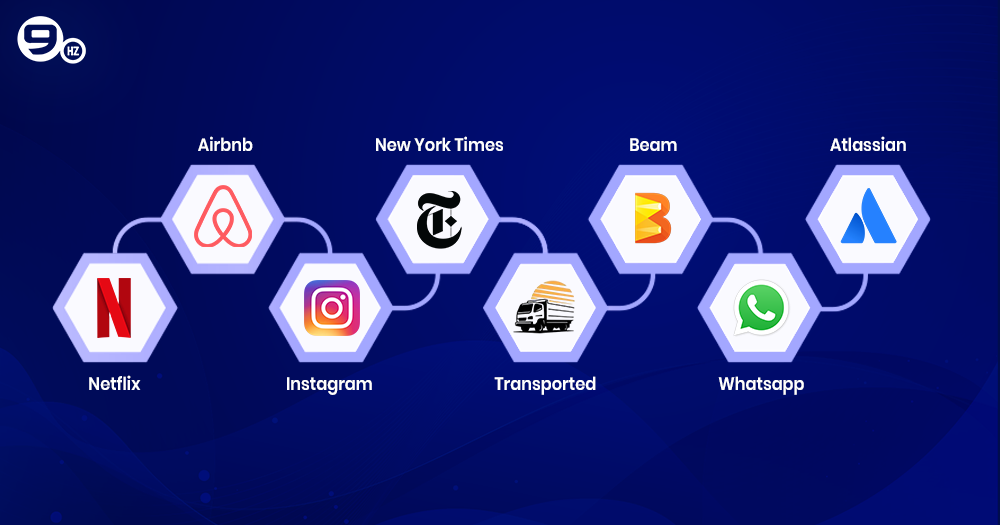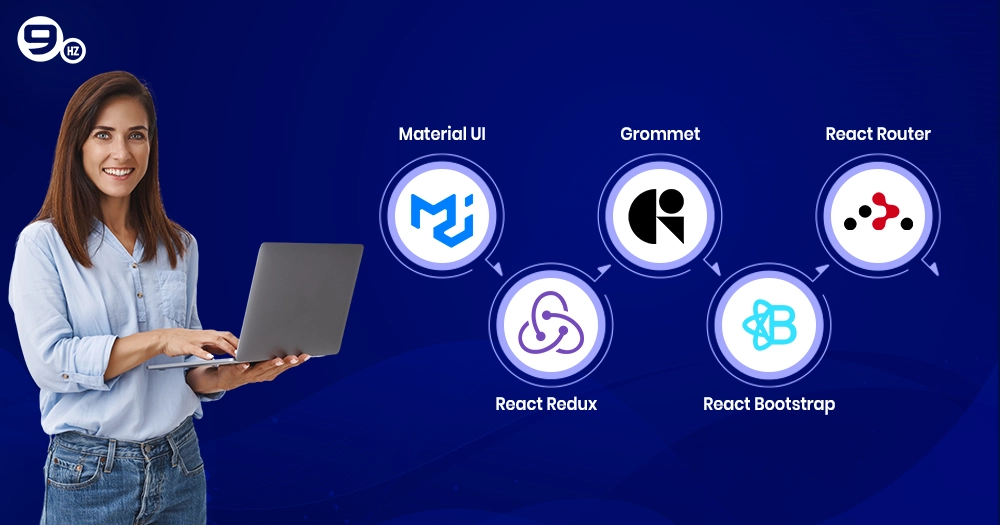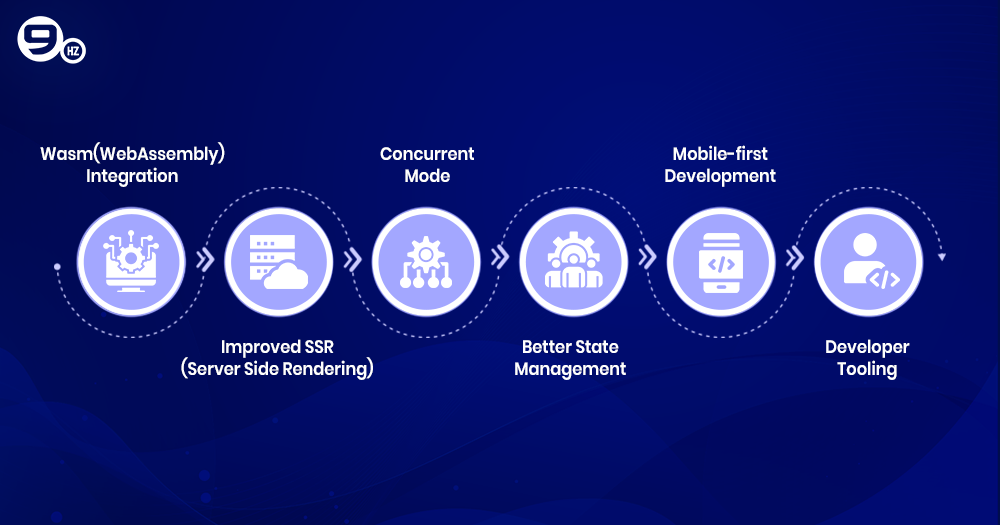React apps are everywhere, and we all use them to watch our favorite series, post our stories on social media, and read emails. Wondering which ones? Just check your phone’s screen for Instagram, Netflix, or Facebook. Yes, these are the most popular apps built with ReactJS development.
You interact with Netflix’s interface while watching the latest episodes of Squid Game or Money Heist. Even the messages you scroll through on WhatsApp rely on its interface. Both are made possible by the miracle of ReactJS- the tremendous technology behind top-rated apps.
React is the most popular web framework recommended and used by 39.5% of developers worldwide. A large community of developers effectively contributes to React, making React.js a smarter choice for developing a professional app.
So, if you want to create a React app but don’t know where to start, partnering with an experienced ReactJS development company can simplify the process and ensure scalable, high-performance results.
This guide will walk you through every aspect, helping you build ReactJS apps for your business.
Let’s continue with the blog!
What is React.js?
ReactJS is a JavaScript library for building interactive UIs (user interfaces). But the definition doesn’t end here. It is not just for creating UIs—it also empowers developers to create complex single-page applications(SPAs). Using this framework, developers create dynamic, lightweight, and scalable applications. As it offers myriad advantages, it is an excellent option for developing modern applications.
ReactJS development allows you to add interactivity wherever you need it. There is a phenomenon behind it, like components receiving data and producing the desired output on the screen. It is easy to pass the data, for example, output based on user-provided input.
One of the most significant advantages of React is that you can make use of the same skills to build interactive web and native apps. Some of its key advantages are:
- Reusable UI Components
- Fast Rendering with Virtual DOM
- Cross-platform Code Reuse
- SEO-Friendly
- Active Open Source Community
- Scalability
- Long-term Stability by Frequent Updates
Key Features of React.js
ReactJS is a more popular framework than other JavaScript frameworks. Its features are the ultimate secret, proving invaluable for developers when building user interfaces and apps using React.js.
Let’s dive into the outstanding features that make ReactJS development a top choice!
Virtual DOM
DOM refers to the Document Object Model and is crucial for web application rendering. The Virtual DOM is a replica of the DOM but works differently. Instead of changing the entire object model, ReactJS compares the virtual DOM with the real one and performs only necessary updates. It allows React’s performance and rendering to be faster.
JSX
JSX, a JavaScript XML, is a JavaScript extension allowing developers to write code similar to HTML using React components. JSX helps keep data handling and UI together simultaneously and enhances code maintainability. Embracing JSX enhances code readability and fosters a more structured and maintainable codebase, which is why React developers prefer it.
One-Way Data Binding
One of React’s specialties is unidirectional data flow—parent to Child. This helps with easy debugging and improves the application’s stability. The child component can only use a callback function to communicate with parents, ensuring seamless data exchange.
Component Based Architecture
The component-based architecture of ReactJS allows developers to break UI elements into components. These components work as reusable independent blocks and come with their own logic, ensuring better maintainability when you develop ReactJS apps for complex projects.
React Hooks
React Hooks(Introduced in version 16.8) allow developers to use state and other React features instead of writing code for a class.
Extension
React offers numerous extensions that allow developers to build ReactJS app with full functionality.It also facilitates mobile app development and offers server-side rendering capabilities.
Best Practices for React Development
Whether you want to develop ReactJS solutions or improve the existing ones, following the best practices can lead to high performance, scalability, and maintainability. Let’s explore what these are:
Evident File and Folder Structure
An organized file structure simplifies navigation, saves time, and prevents confusion. Files can be grouped by similarity (e.g., home.js, home.css) or by features (e.g., home/index.js).
Naming Conventions
Adhering to naming conventions that ensure easy readability is the best practice. These conventions apply to both components and variables. While developing React.js apps, developers use camelCase and PascalCase.
Lazy Loading and Code Splitting
Lazy loading and code splitting are helpful, especially with a large codebase. By using lazy loading, you can limit the loading of a specific section of an app. The bundles are split, and relevant sections are loaded based on user requirements.
Structured Import Order
The structured import order helps segregate external and third-party imports from local ones. It is beneficial when your application grows continuously and external imports are required.
Limited Component Creation
Design a component that allows you to reuse its logic multiple times, eliminating the need to rewrite any of that logic.
Maintaining Code Quality
Keeping the code quality better is the best practice for ReactJS development. ESLint and Prettier are essential tools that help keep your code polished and consistent. They allow for easy debugging and ensure the codebase remains well-organized.
State Management
Effective state management is crucial for seamless data flow and the stability of React projects. The best way to manage the State is to use built-in solutions like useState, useReducer, Redux, and others.
Use React Hooks
React Hooks allow functional components to manage state and handle side effects. Using them helps streamline code and avoid unnecessary re-renders.
Security Practices
Enhance your security by implementing robust HTTP authentication and validating user inputs to safeguard against frequent cyber attacks.
Stay Updated with React Versions
Stay updated with version advancements and improve performance and functionality. The best idea is to update yourself through the React Blog, newsletter, and social media.
Importance of React in Modern Web Development
React has emerged as a powerful front-end development technology for seamless app and web development, helping developers create robust solutions. It offers myriad features, such as a lightweight and efficient framework, empowering web apps to handle high traffic. Here are other crucial reasons for React’s importance in the modern web world.
Reusable Components
The components-based architecture helps React developers to use reusable components to create complex UIs. It reduces efforts and saves developers’ time to develop reactjs website.
Easy to Use
With a basic understanding of HTML and CSS, React is easy to use to develop web apps.
Fast Rendering Virtual DOM
The virtual DOM ensures seamless rendering and user interactions and improves performance by reducing direct DOM iterations.
Seamless Integration
React.js’s integration capabilities are untouchable. You can easily integrate other popular libraries and frameworks with React and, undoubtedly, build web applications.
Flexibility & Scalability
With ReactJS, you can build anything from SPAs (Single-Page Applications) to complex SaaS platforms, MVPs, and large-scale enterprise web applications.
SEO-Friendliness
React’s server-side rendering support boosts page load speeds, eases search engine crawling, enhancing search rankings and SEO effectiveness
Robust Community Support
One of React.js’s biggest advantages is its large community, which offers extensive resources and tools. Developers can leverage this community to solve problems and seek guidance.
High Performance
Handling high traffic, fast rendering, and responsive interactions is vital for modern web applications, and all you can find with React, making it a suitable choice for modern web development.
Till this section, you have walked through key features, best practices, and applicability of React.js to develop a modern web app. Now, it’s time to learn how to build mobile and web apps using ReactJS. Let’s continue with the blog!
How to Build a Reactjs App and Web?
Developing a ReactJS app or website requires knowledge, passion, patience, and a structured approach. It starts with setting up the environment for ReactJS development and ends with deploying the app or web application.
But let’s be honest—not everyone can become a coding expert overnight. That’s where a ReactJS development company comes in. The experts will help you make your idea a real ReactJS app without difficulty.
Let’s start with the steps!
1. Requirement Collection
The first step in development is gathering requirements. Define your goal, identify key features, necessary integrations, and target audience, and determine whether you need a simple or advanced app or website. Document everything clearly to avoid missing any critical details.
2. Planning
Once requirements are collected, the next crucial step is to create an organized development plan to build a ReactJS app. The process refers to planning the structure of your app while considering factors like Component hierarchy, folder structure(src/components, src/pages, src/hooks, etc), State management(using Redux or built-in state management), and testing (how you will test your app).
Other planning steps include selecting tech stack components for the backend, styling, hosting, and deployment. Also, create a roadmap and set milestones and deadlines with the help of the ReactJS development company you’ve hired.
3. Designing
The design process focuses on creating UI/UX elements to enhance user engagement. The first step of designing is creating wireframes and prototypes using tools like Figma, Sketch, Adobe XD, etc.
The next phase of designing a ReactJS app is breaking the UI into components to ensure usability, such as a button and input field.
Here, experts will also assist you in deciding the data flow design and defining color, spacing, and fonts using CSS. Once all the designing tasks are done, it’s time to code the app.
4. Development
At this phase, the developers will write the actual code for your app. They will begin the process of ReactJS development by implementing the core components and modules, leveraging React’s reusable component-based architecture. When developing the app, the focus is on key features such as state management, API integration, authentication, routing, and others.
Optimizing rendering with React’s reconciliation, code splitting, and lazy loading is the best practice to ensure the app’s scalability and performance.
5. Quality Analysis
Testing is more crucial than developing an app, as potential issues might slip through the cracks, or a bug can ruin the user experience. With the help of quality analysts, test your app using different cases and test rigorously until the last bug or security issue is eliminated.
Quality analysts will use key testing types such as Unit testing, Performance testing, Integration testing, E2E Testing(simulating actual user activity), and User testing.
6. Deployment
The deployment process involves launching your ReactJS app to make it available for your customers. While deploying the app, remember to ensure appropriate data migration, seamless connectivity with the server, and a pilot run to remove any issues before users start interacting with it.
7. Maintenance
One thing common among all top apps worldwide is that they regularly update. So, once your app is deployed, monitor its performance and update it periodically to prevent security issues and ensure a seamless user experience.
Top Use Cases and Examples of React.js
Whether you want to develop a video streaming or social media app, ReactJS is one of the best technologies for developing any front-end project. If you wonder what the real use cases or examples of ReactJS development are, here are some inspiring ones:
1. Netflix
An app like Netflix leverages React.js seamlessly across its websites and mobile applications. The component-based architecture helps this streaming services provider offer a seamless user experience across devices.
2. Airbnb
Airbnb is the most popular vacation rental platform and one of the top examples of brands using React.js. The company adopted React technology for its search engine, which displays results lightning-fast.
3. Instagram
The Instagram app offers multiple features, including geolocation, search engine accuracy, and more. Do you know the secret behind it? Yes, ReactJS is behind it, and all the features you access are just because of this technology. The app utilizes the complete ReactJS library.
4. New York Times
The media giant New York Times leverages React for its project, The Red Carpet. It offers simulated looks of film and television stars on Oscar’s red carpet, showcasing them from 19 years ago. Users can view the photographs using filters.
5. Transported
The Transported app is one of the best real estate apps, offering seamless virtual tours of property listings. The power of the React.js app ensures smooth navigation and instant switching of scenes when users access the virtual tours.
6. Beam
Beam, the biggest micro-mobility brand in the Asia-Pacific, adopted ReactJS development for its business. The Beam app offers high performance and scalability while serving millions of customers.
7. Whatsapp
The interface of the top messaging app, WhatsApp, is built using React. The credit goes to React’s Virtual DOM, allowing updates and rendering without refreshing or reloading the whole page.
8. Atlassian
The company has built the world’s top professional tools, such as Jira and Trello. It adopted ReactJS(in 2015) and launched a cloud-based platform, Atlassian Cloud. The technology helped the company develop interactive and highly responsive user interfaces.
React.js Frameworks for Building Modern Web Applications
Now that you’ve explored the top examples of ReactJS app development, you might wonder: if you want to develop a modern web app, what ReactJS frameworks should you use? Here are the top five frameworks:
Material UI
Material UI, an open-source React UI library, uses Google’s Material Design to launch new features quickly. It allows developers to swiftly create components like drop-down, navigation, and slide bar.
React Redux
Redux empowers applications to evolve by efficiently managing the state through a streamlined, unidirectional data flow model. Its other specialty is offering DevTools, which is designed to track solution state changes, maintain logs, and send error reports seamlessly.
Grommet
Grommet is a React framework that offers a seamless blend of accessibility, responsiveness, and customizable themes, all presented in a clean and straightforward design. Developers can easily access it to develop ReactJS websites.
React Bootstrap
React Bootstrap is a robust ReactJS framework that offers significant advantages, including NPM support, CSS support, and customizable Bootstrap. As an original library, it provides a wide range of components.
React Router
React Router is a JavaScript framework that empowers developers to handle client- and server-side routing in React applications. The best part is that when building SPAs for the web or mobile, React Router enables navigation without refreshing the screen.
React vs. Angular: The Comparison
For years, it has been one of the hot topics of discussion among developers: React Vs. Angular. Both are front-end technologies, but some differences set them apart from each other, such as:
| Feature | ReactJS | Angular |
|---|---|---|
| Real Use Case | Facebook, Instagram, Airbnb, Netflix, etc. | Microsoft, IBM, Forbes, Google, PayPal, etc. |
| Launched in | 2013 | 2009 |
| Developed By | Meta | |
| Type | JavaScript Library | Full-fledged Framework |
| Learning Curve | Easy to grasp | Steeper learning curve |
| Architecture | Component-based Architecture | Model-View-Controller (MVC) |
| Language | Uses JavaScript (ES6+) and JSX | Uses TypeScript |
| DOM | Virtual DOM | Real DOM |
| Data Binding | Unidirectional | Bi-directional |
| Flexibility | Highly flexible with third-party integrations | Structured framework with clear perspective |
| Suitable for | Dynamic web apps, Interactive UI | Complex SPAs, Large-scale enterprise solutions |
| Performance | Faster rendering with Virtual DOM | Slightly slower due to real DOM manipulation |
| Dependency Injection | Not Supported | Fully supported |
Still, if you have a question, which one should you choose: ReactJS vs Angular?
You can choose Angular if you want to develop a large-scale enterprise app. However, if you need better flexibility and performance, ReactJS development is the right choice.
Reactjs Development Trends
According to BuiltWith statistics, ReactJS is among the most often used JavaScript libraries for web development, with about 39.16 million active websites worldwide. As technology advances, ReactJS will become a top JavaScript library in the upcoming years. Here are some emerging ReactJS development trends shaping the future of app and web development.
Wasm(WebAssembly) Integration
WebAssembly enables near-native-speed web applications, and integrating React with Wasm enhances computational efficiency when handling complex tasks and algorithms.
Improved SSR(Server Side Rendering)
Server-side rendering (SSR) will become increasingly crucial in the coming years. It improves page load speeds and SEO by rendering React components on the server and delivering them as static HTML to the client.
Concurrent Mode
Concurrent Mode enhances React JS application efficiency and responsiveness by providing new capabilities and patterns, such as transitions, suspense, and error boundaries.
Better State Management
With ReactJS, State management will evolve constantly. In addition to popular libraries like Redux and MobX, newer tools like Recoil are expected to be the best for better state management.
Mobile-first Development
Mobile-first development is gaining popularity due to increasing internet usage, and the framework simplifies the process for developers to develop ReactJS solutions.
Developer Tooling
React DevTools and the Profiler will continue to evolve, presenting developers with deeper insights into app performance and helping them refine their code.
With the above-mentioned trends, React technology will become more influential, and brands will leverage it to develop ReactJS apps, professional websites, and dynamic user interfaces.
Why Choose The NineHertz for ReactJS Development
The NineHertz- a leading ReactJS development company is your go-to partner for developing scalable and adaptable solutions customized to your needs. Our skilled team of developers can help you create a modern app that incorporates W3C and ECMAscript standards using ReactJS.
Our expertise lies in delivering top-notch solutions focusing on virtual DOM, reusable components, JSX, and server-side rendering for fluid performance. Customization is one of our core strengths, allowing us to exceed our clients’ expectations.
With extensive industry experience, we have honed our ability to deliver cost-effective solutions within client-defined timelines, leveraging the latest technology stack. Our proven track record of serving diverse industries makes us the right choice for your next project.
Frequently Asked Questions
What is ReactJS, and why should I choose it for my project?
React.js is a JavaScript library for building dynamic and responsive user interfaces. Its benefits, such as reusability, easy learning curve, and fast loading speed, make it an excellent choice for your project.
What types of projects are best suited for ReactJS development?
ReactJS is a perfect choice for developing projects such as:
- Dynamic User Interfaces
- Single-page Applications
- Data-driven Applications
- Content Management Systems
- E-commerce platforms and more
Do you offer custom ReactJS development services?
Yes, we do. Our custom ReactJS development services deliver tailored solutions aligning with specific business and industry needs. Leveraging concepts like virtual DOM, server-side rendering, code splitting, and others, we can help you develop ReactJS solutions with ultimate flexibility.
How long does it take to develop a ReactJS application?
The timeline for building a ReactJS app depends on complexity, project requirements, developers’ expertise, features, and functionalities. However, as a rough estimate, essential ReactJS app development takes less time than an advanced one.
Do you provide ongoing support and maintenance for ReactJS projects?
Yes, we do! We are here to assist you from the beginning of the project to beyond its launch. For more details, you can contact us anytime.
What are the advantages of ReactJS over other JavaScript frameworks?
Compared to the other JavaScript frameworks, ReactJS offers several advantages, such as code stability, high performance, component reusability, faster loading time, declarative syntax, and one-way data binding.
How much does ReactJS development cost?
The ReactJS development cost depends on complexity and requirements, which vary from project to project. You can share your requirements with us anytime to better understand your project development cost. Once we analyze them, we’ll get back to you with all the details.
Great Together!


